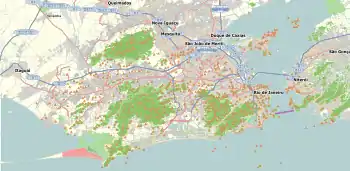Cosme Velho
Cosme Velho is a neighborhood in the South Zone of Rio de Janeiro, adjacent to Laranjeiras. Its main street is Rua Cosme Velho, an extension of Rua das Laranjeiras. Cosme Velho is frequently visited by tourists.
Cosme Velho | |
|---|---|
Neighborhood | |
 Cosme Velho Location in Rio de Janeiro  Cosme Velho Cosme Velho (Brazil) | |
| Coordinates: 22°56′34″S 43°12′00″W | |
| Country | |
| State | Rio de Janeiro (RJ) |
| Municipality/City | Rio de Janeiro |
| Zone | South Zone |
The Estação de Ferro do Corcovado (terminus of the Corcovado Rack Railway) is located here. Trains carry passengers from there to the summit of Corcovado Mountain and the statue of Christ the Redeemer.
The neighbourhood also includes the picturesque Largo do Boticário, which consists of a small square enclosed by several neocolonial style houses, built in the 1920s. The houses were constructed using materials from much older buildings in the city's Centro district which had been demolished. There are two houses from the first half of the 19th century at the entrance to the square.
The writer Joaquim Maria Machado de Assis lived in a house at 18 Rua Cosme Velho from 1883 until his death in 1908. Machado acquired the nickname "Bruxo do Cosme Velho" ("Wizard of Cosme Velho"), supposedly because he was in the habit of burning his discarded documents in a cauldron. The house has since been demolished and an apartment block has been built in its place.
Education
The Associação Civil de Divulgação Cultural e Educacional Japonesa do Rio de Janeiro ("Civil Association of Japanese Educational and Cultural Dissemination of Rio de Janeiro", known in Japanese as the "Rio de Janeiro Japanese School"), a Japanese international day school, is located in Cosme Velho.[1]
References
- "学校紹介 Archived 2015-01-12 at the Wayback Machine." Associação Civil de Divulgação Cultural e Educacional Japonesa do Rio de Janeiro. Retrieved on March 18, 2014. "Rua Cosme Velho,1166,Cosme Velho RIO DE JANEIRO,R.J,BRASIL,CEP22241-091"
- Much of the content of this article comes from the equivalent Portuguese-language Wikipedia article (retrieved September 25, 2005).